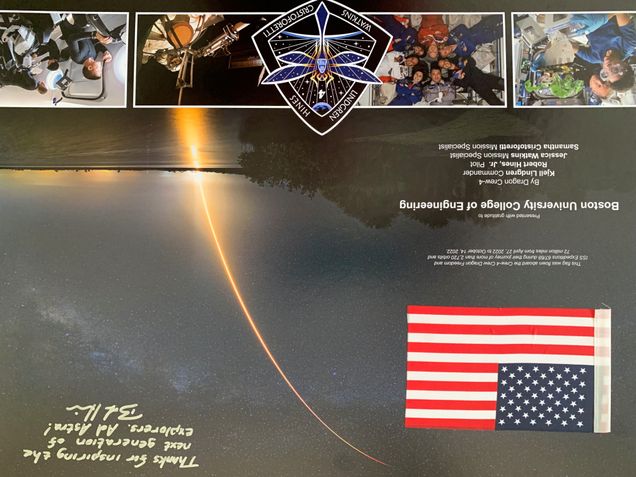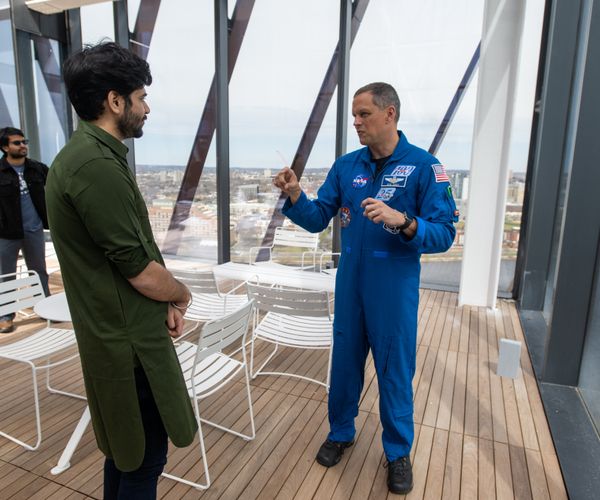A Journey to Space, and a View of a Fragile Planet
By Patrick L. Kennedy
NASA astronaut Robert Hines (ENG’97) returned to Boston University to recount his six-month space voyage aboard the International Space Station last year, and the long journey before blast-off. A hundred students balancing box lunches on their laps listened as Hines shared stories of his aerospace career, from flying parabolas in a test plane nicknamed the “Vomit Comet” to growing tomatoes in space—a first for mankind.
“I think I have something in common with a lot of astronauts,” Hines said. “Ordinary people who got lucky and worked hard, got to do extraordinary things and work with extraordinary people.”
Hines earned a bachelor’s degree in mechanical engineering at BU, where he particularly enjoyed aerodynamics courses with Associate Professor Sheryl Grace (ME).
“I loved space,” Hines recalled, “but I didn’t consider ‘astronaut’ a realistic career option. To me, those guys were superheroes.” Eventually, he would learn that “there’s a cast of thousands doing work below the surface—analysis, monitoring, operations. It’s humbling.”
Hines joined the U.S. Air Force after graduation, became a pilot and flew 76 combat missions in the Middle East. He earned a master’s degree in engineering from University of Alabama and became a research pilot, flying test planes such as a C-9 jet modified to fly a parabola, which induces 40 seconds of weightlessness and is used to train astronauts.
Not all astronauts started out as pilots, Hines told the students, pointing to NASA colleagues who came from engineering, computer science, microbiology, and physics backgrounds.
In 2017, NASA accepted Hines into the astronaut program and, after five years of rigorous training, he piloted NASA’s SpaceX Crew Dragon craft, with three crewmates aboard, 250 miles up to the ISS.
There, over 170 days, the team monitored 250 science experiments, in microgravity, robotics, hydroponics, and other fields. Notably, the team succeeded in growing dwarf tomatoes. “We’ll need that technology if we want to go to Mars—the ability to grow food, purify the air with plants, not to mention the psychological benefits of seeing that greenery.”
The best part of orbit was the view of Earth, said Hines. He didn’t see borders dividing countries; he saw lightning, aurora borealis, sandstorms. “It was transformational,” said Hines. “It affirmed my faith in God and belief that we’re all part of a human race and we need to get along and respect one another.” And with little to see around the planet but black emptiness, “it’s an oasis of life from that view. How fragile and valuable and special it is.”
Hines’ Lunch & Learn event was co-sponsored by the College of Engineering, the Mechanical Engineering Department, and the BU student chapter of the American Institute of Aeronautics and Astronautics. During his visit to campus, Hines also made time to meet with students from The Calculus Project and BU Academy.

Top: Hines chats with Shubham Iaiwala (ENG’24) April 7 on the 17th floor of the CCDS. Photo by Cydney Scott
